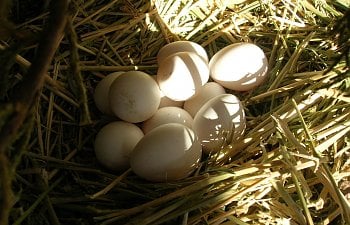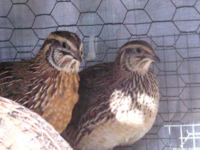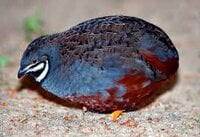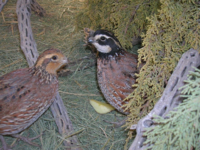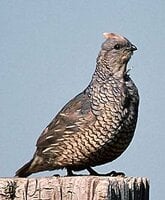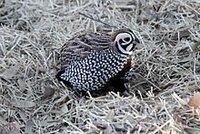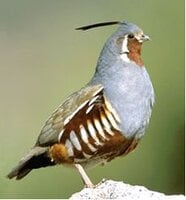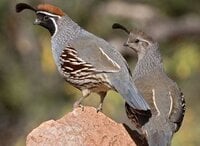The Quail As A Species
There are 130 different Quail species all around the world. However, this article is going to concentrate on the most commonly kept species, those that have been domesticated. No matter how different each of these species of Quail are, they share many characteristics in common. Most are quite amiable if kept properly. Quail have long been prized for their melodious calls and song. Many species are named after their calls as well. Males have the distinct voice and appearance and the females bearing similar appearance but of lighter shades.
Once you have decided you want to keep Quail, you will need to decide on a species you wish to keep. Many factors can sway you to pick a certain species depending on why you wish to keep them. They each have their own wonderful characteristics and beauty; however, some are easier to keep than others. Some are better keeping for meat or eggs and others are strictly kept for their calls or feather patterns. So let's go over the individual species and then discuss how to pick your species!
Quail Species: Old World Quail
Japanese Quail
Brief History:
Japanese Quail are migratory birds which migrate between Asia and Europe. They are said to originate in southeast Asia. There is reference to Quail in the Bible and even the Egyptians kept these migratory birds for meat and eggs. In the late 11th century, Quail were brought from China to Japan. It was believed the Japanese Emperor at the time was cured from Tuberculosis by eating Quail meat. Japanese Quail, more commonly called Coturnix Quail, are called Coturnix because of the males crow, "ko-turn-eex".
Coturnix Quail
Description:
Japanese Quail: Also known more commonly as Coturnix Quail, Pharoah Quail, and Jumbo Coturnix Quail. Adult Japanese Quail females are generally larger than the males and weigh in the range of 120 - 160 grams. (4.5 to 6 ounces). The males are slightly smaller, weighing in around 100 to 140 grams (4 - 5 ounces). With a selective breeding program, a larger bird can be produced. Some colors of Coturnix can be sexed as early as 3 to 4 weeks of age based on feather patterns. Males will have a rusty orange breast and throat. The females will have more of a whitish breast with a speckled breast. They are generally sexually mature by 7 to 9 weeks of age. Average life expectancy of these birds is 2-5 years of age, depending on their health and how they are kept.
There are many varieties of Coturnix as well. The fun thing about this species of quail is that they come in so many different colors and mutations.
*Jumbo Coturnix: Jumbo Coturnix Quail are just larger selectively bred Coturnix and are commonly used for meat. Jumbos can weigh in at nearly 16 ounces.
*The Texas A&M: Developed by professors at the Texas A&M University to be a heavily muscled Coturnix and weigh in around 10 to 13 ounces. They have white meat and pure white feathers.
*The English White: Smaller than the Texas A&M but genes from this bird were incorporated into the Texas A&M. They come in pure white or white with brown spots on the head and back. Pure white meat.
*The Golden Coturnix: Also known as Manchurian and Golden Speckled. These birds come in standard and jumbo sizes.
*Tibeten: These are a dark chocolate in coloring, which is a result of two copies of the extended brown gene.
*Tuxedo: This is a color pattern, rather than a color. It was originally produced by breeding a Texas A&M with a Tibetan. These birds can now be found in nearly all colors of Coturnix.
*Rosetta: This color is the result of one copy of the extended brown gene. As such, the color is a lighter version of Tibetan. Breeding two Rosettas together will result in 50% Rosetta, 25% Tibetan, and 25% Pharoah colored chicks.
This is the fun part about Coturnix Quail. You can cross breed colors and come up with many different variations in your flock.
The Coturnix is a very good beginner species to keep. If you have never raised Quail before, this is the species to start with. They are easy to handle, and they do not require as much square footage per bird as many of the other species. They are less aggressive than other Quail species and mature much faster as well. They can be ready for the table at 6 or 7 weeks of age and be breeding and laying at 9 weeks of age. So you can turn these birds over very quickly if you are keeping them for meat. They are also more docile too and for those of you that want a fun little house pet, Coturnix are the way to go! Work with them as babies and they can be real snugglers unlike other species of Quail. Coturnix are not as skittish as other species of Quail and because they have been domesticated for thousands of years are much more tolerant of human contact. A very docile species of Quail.
Coturnix are kept 1 rooster to 5 to 7 hens. Any more hens and your fertility can drop. Any fewer hens and the rooster can mate the hens to death. If you are only keeping these birds for eating eggs, then I suggest not keeping a rooster. The hens are far better off without a rooster and will continue to lay at the same rate, maybe even a better rate without a rooster bothering them. You can then keep as many hens together as you wish as long as you stick to the proper square footage per bird.
Housing Coturnix is not that difficult and I will go into housing Quail further in another article. However I will say this much...some people say that 1 square foot per bird is enough for Coturnix however I do not agree. I think 2 square feet is a much more tolerable space to keep them in to keep aggression down and health up. Coturnix take up less space than other species of Quail. This species is the easiest starter Quail and I recommend this bird to all beginners. These birds do not require a license to keep here in the United States.
Button Quail
Brief History:
Chinese Blue Breasted Quail, AKA King Quail, Painted Quail and also known as Button Quail, are a fun little bird that has fascinated people for centuries. From earliest times in China, they were kept in small cages, and believed to bring good fortune to those that cared for them. They no doubt get their name because chicks are as tiny as a button. Although somewhere along the ages, the name Button Quail was stolen from another species, the true Button Quail that is not a Quail at all and while these "true" Quail resemble Quail, they are unrelated to the family of birds called Quail in the Phasianidae family such as the ones we are discussing here.
Description:
They are a very tiny bird weighing in around 1.4 ounces. They come in a beautiful array of colors and mutations - Normal Wild, White, Red Breasted, Blue Faced, Cinnamon, Tuxedo Pied, Splash Pied, and a few others. Being that these birds live their wild lives in warm climates, these little birds must be kept indoors at all times and can be kept in cages or aquariums, even indoor aviaries. Button Quail make a small, neat, moderately quiet indoor pet that is easy to keep and breed. They can live to be 3 to 5 years in captivity. The hens lifespan may be shorter due to egg laying and depletion of calcium. They are kept in pairs only.
Sexing can be difficult with certain color variations and sometimes you many need to just observe their mating behaviors. However, males in certain mutations have a white line or bib on their throat. Some bibs, like in the Red Breasted males, are a single thin white line. With all the new mutations being bred into these birds, some of these markings are being lost in the genetics. Another indicator is red or blue feathering. Females never show these colors. Blue is solely a mark of a male seen in the Blue Faced, Red Breasted, and Wilds. Red, not to be confused with Cinnamon colors, is a deep brick red color. This red is seen on the vent areas of all males. If you see red on the vent, you have a male. Vent color sexing is a sure bet and is easy to do.
Button quail are sexually mature and start laying sometime between 8 to 12 weeks of age. 4 square feet or more for a pair will keep them happy. You cannot handle much or snuggle this bird without great stress to the birds, they are for viewing only. I have heard on occasion that some like to have their throats scratched, but for the most part you do not handle them. However their beauty and cuteness makes up for them being untouchable and can really color up your home with their unique colors and their fun little personalities! You do not need a license to keep this bird in the United States.
Quail Species: New World Quail
Bobwhite Quail
Brief History:
Bobwhite Quail are native to much of the continental U.S. It is a member of the group known as New World Quail. There are 20 subspecies of Bobwhites that inhabit the U.S., the Caribbean, and Mexico. They get their name from the famous call of the male when he is looking for a mate....Bob, BOB, WHITE! The Native Americans utilized Bobwhites for food as their numbers increased around crop fields. In 1557 Hernando DeSoto's expedition reportedly received Turkeys and Bobwhite Quail in a Native American village in Georgia, becoming the earliest record of white men eating Bobwhites.
Hunting this game bird was common in the 1800's and over time the sport of Quail hunting became a gentleman's pastime. Current wild populations of these birds have been rapidly declining over the past century due to loss of habitat and other farming practices. Bobwhites have completely disappeared in some areas of the U.S. One of the subspecies is already extinct.
Description:
There are several subspecies and mutations of Bobwhites that are commonly kept in captivity, including the Northern Bobwhite, Butler Bobwhite, Snowflake Bobwhite, Georgia Giant Bobwhite and Tennessee Red Bobwhite. The average Northern Bobwhite weighs in at about 170 grams (6.0 ounces). Butlers, if bred for size, can weigh in at nearly 16 ounces, although the average male is probably 12 ounces. Georgia Giants can be 3 times the size of a Northern. Tennessees and Snowflakes are sized somewhere between the Northerns and the Butlers. These are all non-migratory birds.
Bobwhites can be aggressive, however of these birds I have just described, if you get good stock the Snowflakes will be the least aggressive. The Tennessee will be the most aggressive. The reason behind a Bobwhite's aggression is that unlike the quail of the Old World such as the Japanese Quail or the Button Quail, both of which have been kept in captivity for thousands of years, the New World Quail such as Bobwhites have only recently (within the last quarter century) come to be kept around humans and in cages or pens. They have not yet adapted to being in such close quarters with each other in confined spaces, or being around humanity. So in other words they are skittish and stress easily, which can cause them to turn on each other.
They do not take kindly to having lost their freedom. (If you work with them as chicks, you can tame them down somewhat.) Bobwhites and all of the New World species of Quail flush easily, panic rather quickly, and must be kept properly to ensure their safety from each other and from hurting themselves in fear.
You can sex most of these species at 12 weeks, although the Tennessee Reds can be a bit tricky and many times you need to watch their mating behavior to figure out who is who. The rest of these species are sexed by their feather coloring. The males will have black masks and more black on their heads and faces, whereas the females will have a buff brownish color on their faces. The snowflake females will have more of a grey face than dark black masks as the males do.
Bobwhites are sexually mature at around 6 months of age; however, they generally wait until the next spring following their hatch to lay and mate. They are fully mature at one year. These birds are seasonal layers and lay during their breeding season of April through September. You can use forced laying during the off breeding season. This will however shorten their lives and can put stress on a body not designed to lay year round.
Bobwhites are kept in pairs ONLY. Never keep these birds in trios or mix breeding pairs. They are very aggressive and can and do kill each other. However, you CAN mix these birds after the breeding season is over. In the wild, Bobwhites gather for the winter covey every fall, sometimes numbering in the hundreds. They spend the fall and winter together only to disperse that following spring, finding their own territory to raise their young. Your Bobs will naturally want to come together as well. Friends reunite, grudges are let go and they all enjoy the company of their large group. The following spring you will need to separate your pairs. You can keep first year Bobs all together until the following spring.
Bobwhites are known to sometimes mate for life. It is the female that does the picking. So keep track of who is with who when you separate the pairs each spring. They will not take kindly to being separated from their mates. Leg bands work really well for this purpose if you have too many to recognize. Bobwhites are hyper and have a lot of energy and REQUIRE at least 4 square foot PER bird as adults. If they feel cramped, they will turn on their mates. Young Bobs less than a year can tolerate 2 square feet per bird. They become more aggressive toward each other each year of their lives. If you are keeping this species for eating eggs only, you can keep the females together year round at 4 square feet per bird.
Males can be kept together in this fashion as well. As long as either sex cannot SEE each other, keeping all males or all females together does work year round. You do not handle Bobwhites and only do so for medical reasons. They can panic to the point of injuring themselves in your hands and even dying from shock. BUT, if you raise these birds from chicks yourself and handle them a LOT as babies, this will make them easier to pick up as adults. They still will not like being picked up, but are less likely to hurt themselves or die in your hands. The average lifespan of these birds is 2 to 5 years of age, although a 7 year old Bob is not unheard of.
This bird is not as commonly kept for a meat bird as Coturnix quail are, however they also dress up nice for the table by 14 to 16 weeks of age. Some will tell you Bobwhite meat is superior in taste to other quail species, however because they mature up later, Coturnix Quail are generally more widely raised for meat. While I do not recommend this species for beginner Quail keepers, if you have your heart set on one of the New World species, then chose this species over the others. Bobwhites are the easier bird in the New World order to keep. You will need a license from the Fish and Wildlife Service to keep this bird.
Gambel's Quail
Brief History:
The Gambel's Quail is a non-migratory bird of the Desert Southwest. It inhabits the regions of Arizona, New Mexico, Colorado, Texas, Utah and parts of Northern Mexico. It gets its name from William Gambel, a 19th century naturalist and explorer who died on an ill-fated winter crossing of the Sierra Nevada.
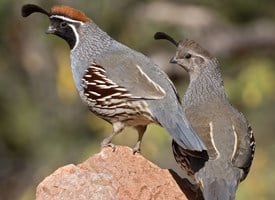
Description:
These cute little birds are recognized by their feather plumes or top knots on top of their heads, and the scaly plumage on their undersides. They look and act very much like the California Quail however the two species' ranges do not over lap. (So this section of Gambels pertains to the California Quail as well). These tubby little birds can be seen scurrying from underbrush to underbrush, in single file lines, top knots bobbing! These are the Quail that inspired me to start keeping Quail. Their calls are just adorable!
However, they are not a beginner bird to keep and I do not recommend this species to anyone that has never kept Quail in the past. Because they have only recently come on the scene to being kept in captivity, they are very very high strung, antsy, and flush very very easy. I recommend these birds be kept in aviaries for this reason as they can fly up and boink their heads on the ceiling of cages so easily killing them. You cannot handle this species without great stress on them. However for the experienced Quail keeper, I can tell you they are a delightful little bird to keep! They are kept just as Bobwhites are kept, so see the above article on Bobwhites.
Gambel's are easy to sex around 12 weeks of age. The male will have a black mask on the lower face, white stripes above this black, and a rust colored head. The female will be a dull buff brown face. Their life expectancy is about 2 to 5 years of age. They are sexually mature at 6 months of age but generally hold off on laying and mating until the following spring. Just as Bobwhites, they mate for life and are kept in pairs ONLY. 4 square feet per adult bird and they can also be kept all together before they reach one year of age. They too can be mixed together for that winter covey and separated again the following spring. If you are keeping this species for eating eggs only, you can keep the females together year round at 4 square feet per bird. Males can be kept together in this fashion as well. As long as either sex cannot SEE each other, keeping all males or females together does work year round. This bird is generally not kept as a meat bird and is more just a fancy bird to keep. You will need a license from the Fish and Wildlife Service to keep this bird.
Mountain Quail
Brief History:
The Mountain Quail is the largest Native Quail species in the U.S., weighing in between 189 - 262 grams (6.7 to 9.2 ounces). The Mountain Quail was around before the Bobwhite. They inhabit the mountainous areas of California and Oregon, parts of Nevada, and there is even a subspecies in the mountains of northern Baja California. There are 5 subspecies of Mountain Quail. It can be found up to 3000 meters (9,800 ft) above sea level. It is a non-migratory species although some may change their altitude depending on the severity of the seasons.
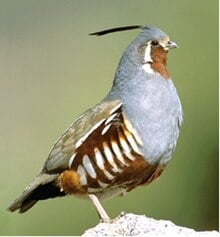
Description:
Mountain Quail are distinguished by their long slender feather plumb, or top knot on top of their heads. This is another species that I do not recommend for the beginner Quail keeper. This bird can be hard to keep alive even early on in life. The chicks are hard to get started eating as in the wild the parents help feed the chicks for some time. So you have to really work with the chicks after hatch. They are very slow to learn to eat. But for the experienced Quail keeper, they are by far the prettiest and the most interesting of the Quail species! They need to be handled a LOT as chicks to tame them up as adults and even then they are very very skittish birds. As adults they can be highly susceptible to disease as they have not yet developed the immunity to the things that other cage kept Quail have endured.
They can be difficult to sex, however with close inspection many times you can come to a conclusion. Females have a slightly shorter and more brown plume than males. The male is also more brightly colored beneath and the grey of the hind-neck is more defined than that of the female. In females, the brown back color extends to the top of the head while in the males the back of the neck is greyish blue. The neck color is probably the most reliable criterion for distinguishing sex.
These birds are raised in the same fashion as Bobwhites and Gambel's Quail and mature up in the same time frame as well. They are kept in pairs ONLY and require 4 square feet per bird as adults. These birds also mate for life. They can also be mixed together as Bobwhites and Gambels are each fall and winter and separated with their respective pairs come next spring. As Bob and Gambel's hens or roosters can be kept together year round, so you can with Mountain Quail. These birds are never kept as meat birds but rather for the beauty this bird carries. You will need a license from the Fish and Wildlife Service to keep this bird.
Montezuma Quail
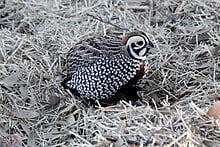
Blue Scale Quail
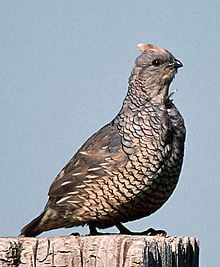
Both of these species can be very difficult to obtain and are rarely kept by Quail keepers just for this reason. Both of these species inhabit the desert southwest of the U.S. and into Mexico. These birds are very secretive in their living and breeding habits and not a lot is known about these birds. These Quail live wild in my area here of New Mexico and in the past 20 years I have only seen either of these breeds a few times. They are very good at keeping well hidden from humanity. They tend to hold off on breeding during dry summer seasons and can raise a couple broods on those rainy years. Their average lifespan in the wild is 8 months to 2 years of age. Like all the other New World Quail, they mate for life and will all come together for the winter covey. They are kept in the same fashion as the Bobwhite, Gambel's and Mountain Quail. You will need a license from the Fish and Wildlife Service to keep this bird.
Picking The Right Species For You
The species that I have just discussed are the most common of Quail that are kept in captivity. They can be a fun type of poultry to keep. If you keep them properly, they can thrive for years and give you healthy meat, eggs or just plain enjoyment!
If you are looking for a fun colorful house pet, then go with the Button Quail.
If you are looking for a good meat bird that is easy to raise and fast growing, pick the Japanese or Coturnix Quail.
If you are interested in keeping Quail for the eating eggs, Coturnix or Bobwhite is the bird for you.
If your interest lies in the more exotic Quail for their beauty and their interesting calls, you can't beat the Bobwhite, Gambels or Mountain Quail.
And finally if you have kept all of these species and are looking for something a bit more interesting, see if you can get a hold of some Montezuma hatching eggs. The beauty of these birds is just incredible. You won't be able to take your eyes of them!
So whichever species you keep, enjoy your Quail!! Their colorful patterns, their interesting calls and the way they giggle for their mates when they have food will keep you coming back for more. If you work with them a bit, they will reward you with eating from your hand, come running to you when they see you carrying that goody bag and entertain you for years to come.
Happy Quailing!
For more information on getting started with quail and getting licensed, see this article:
https://www.backyardchickens.com/a/getting-started-in-raising-and-keeping-quail
Link to the Fish and Wildlife Service by state:
http://www.fws.gov/offices/statelinks.html
For more help with your Quail, stop by our Quail section here on BYC:
https://www.backyardchickens.com/f/48/quail

